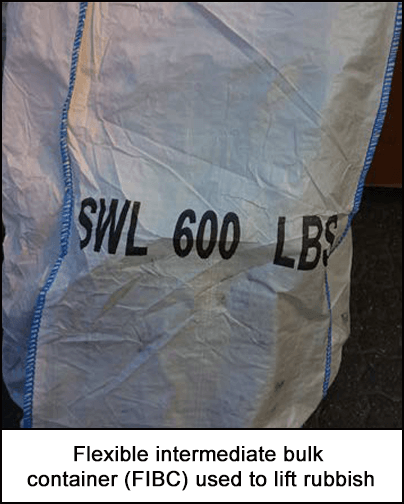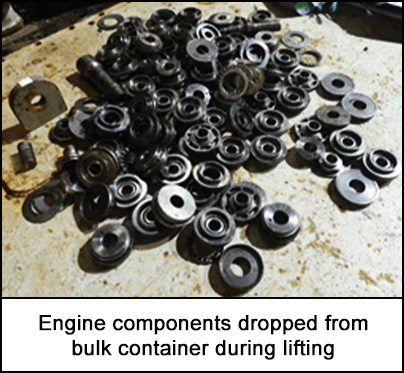-
What happened?
A flexible intermediate bulk container (FIBC) was being used to lift rubbish from a below deck area on a vessel.
As the FIBC came through the hatch, high winds forced it into contact with the crane boom.
The shock load to the bag tore the bottom open.
The lift supervisor called an ‘all stop’ over the radio, but this was not heard by the crane driver.
The contents – which unknowingly included metal components weighting several kg / lb - were dropped across the deck and quayside, falling up to 25 metres (82 feet).
There were no injuries, but there was potential for fatality from the dropped loads.

-
Why did it happen?
The lift crew were unaware that metal components weighing 1.1kg – 2.3kg (2.5lb – 5.5 lb) had been put into the FIBC and then covered over with cardboard and paper.
These components punctured the bag.

-
What did they learn?
Inspect FIBCs to ensure they are free from damage.
Do not re-use FIBCs.
Do not use them for disposal of anything that can puncture the bag.
Make sure all workers are clear as to what material can be put inside FIBCs.
Check FIBC contents (where practical) prior to lifting to ensure correct waste is inside.
Lift FIBC as per the manufacturer and supplier’s instructions.
Consider the use of tag lines to control lifts where practical.
Ensure vessels have appropriate storage containers for scrap metal.
Ensure that suitable lift baskets are available for the transportation or movement of loose items.

-
Ask yourself or your crew
How can something like this happen here?
What can we safely put inside a FIBC?
What things should we not put inside a FIBC?
How can we know what is inside a FIBC? What inspections can we conduct?
How else can we control or mitigate the risk of dropped objects from a FIBC?

Add to homescreen
Content name
Select existing category:
Content name
New collection
Edit collection
What happened?
A flexible intermediate bulk container (FIBC) was being used to lift rubbish from a below deck area on a vessel.
As the FIBC came through the hatch, high winds forced it into contact with the crane boom.
The shock load to the bag tore the bottom open.
The lift supervisor called an ‘all stop’ over the radio, but this was not heard by the crane driver.
The contents – which unknowingly included metal components weighting several kg / lb - were dropped across the deck and quayside, falling up to 25 metres (82 feet).
There were no injuries, but there was potential for fatality from the dropped loads.

Why did it happen?
The lift crew were unaware that metal components weighing 1.1kg – 2.3kg (2.5lb – 5.5 lb) had been put into the FIBC and then covered over with cardboard and paper.
These components punctured the bag.

What did they learn?
Inspect FIBCs to ensure they are free from damage.
Do not re-use FIBCs.
Do not use them for disposal of anything that can puncture the bag.
Make sure all workers are clear as to what material can be put inside FIBCs.
Check FIBC contents (where practical) prior to lifting to ensure correct waste is inside.
Lift FIBC as per the manufacturer and supplier’s instructions.
Consider the use of tag lines to control lifts where practical.
Ensure vessels have appropriate storage containers for scrap metal.
Ensure that suitable lift baskets are available for the transportation or movement of loose items.
Ask yourself or your crew
How can something like this happen here?
What can we safely put inside a FIBC?
What things should we not put inside a FIBC?
How can we know what is inside a FIBC? What inspections can we conduct?
How else can we control or mitigate the risk of dropped objects from a FIBC?
A flexible intermediate bulk container (FIBC) was being used to lift rubbish. As the FIBC came through the hatch, winds forced it into contact with the crane boom, tearing the bag. The contents were dropped across the deck and quayside.














